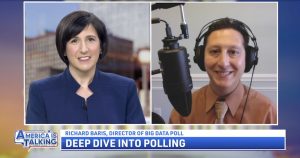A lot of election 2020 is mysteriously similar to election 2016. Joe Biden is campaigning heavily in Pennsylvania, even the same places Pittsburgh, Latrobe, Greensburg, and Johnstown where Hillary Clinton campaigned in the final weeks of the 2016 race. He is attracting "white middle class" voters, considered a mainstay of the Trump base, but who was also the type of voter Hillary Clinton was attracting. She only turned out younger and more diverse people when she paired her appearances with a Katy Perry or Bruce Springsteen concert.
Mainstream polls are mimicking 2016 too. In Pennsylvania, Biden has maintained high leads over President Trump: today they show him as winning by 7%. Likewise, in 2016, Hillary Clinton was ahead by 3.9%, in polls with third-party candidate Gary Johnson received 4% of the vote, they forecast her as having a 77% chance of winning. People from both Trump and Biden camps are unsure whether history will repeat, whether polls will again fail to understand which voters are going to turn out.
In fact, several non-mainstream polls/pollsters who identified trends predicting a Trump victory in 2016, are showing very different results.
Non-mainstream pollsters
First up is Robert Cahaly, from the Trafalgar Group polling organization. In 2016 he showed Trump with a lead in Michigan and Pennsylvania going into Election Day. He also showed Trump ahead in North Carolina and Florida, both of which he won. Cahaly did not have Trump ahead in the key state of Wisconsin only because he did not poll Wisconsin.
Why Cahaly predictions were more accurate is because he used different methods to the mainstream pollsters and managed to identify voters who were likely to vote but had been “inactive” in the recent election cycles. Mainstream pollsters tend to poll only registered voters or use a “likely voter screen,” based on whether someone voted in the past.
Cahaly was also the originator of the prescient formula of asking voters who they were supporting in 2016, then following that up by asking them whether they thought their neighbors were supporting Trump or Clinton. This is what sparked the idea in Cahaly that there was a “shy Trump voter effect.” There was a consistently high variance between who respondents said they were voting for and who they thought their neighbors were voting for -supporting the idea that people won’t tell pollsters their true intentions for fear of being bullied or stigmatized.
 Cahaly’s method again held steady in the 2018 elections with Trafalgar pollsters correctly predicting Ron DeSantis’s gubernatorial victory in Florida, Rick Scott’s senate victory winning the Senate race there. Trafalgar/Cahaly said both would be narrow outcomes with likely recounts. They were also right in predicting Senate outcomes in Missouri, Montana, North Dakota, Texas, and West Virginia making them the most accurate pollster of 2018 elections among those firms polling Senate and governor races.
Cahaly’s method again held steady in the 2018 elections with Trafalgar pollsters correctly predicting Ron DeSantis’s gubernatorial victory in Florida, Rick Scott’s senate victory winning the Senate race there. Trafalgar/Cahaly said both would be narrow outcomes with likely recounts. They were also right in predicting Senate outcomes in Missouri, Montana, North Dakota, Texas, and West Virginia making them the most accurate pollster of 2018 elections among those firms polling Senate and governor races.
Methodologies
Cahaly believes his methods and methodology will be even more valuable for 2020 as low voter response rates and “shy Trump effect” distort and elude the methods used by mainstream pollsters. For example, 11.7% of Republicans say they would not give their true opinions about their preferred presidential candidate on telephone polls. 5.4% of Democrats said the same, and 10.5% of Independents fell into this “shy voter” category. So, let's hypothesize: if you take the 10.5% of independent voters, who make up about 26% of a poll, that would constitute 2.6%, add in the “shy Republicans” at approximately 6%, adjust for a standard 3% margin of error in either direction, and all of a sudden Joe Biden’s 7 or 9% lead is thrown into question. In fact, it would bring the result to around where another non-mainstream pollster - the Democracy Institute has the race: Trump with a 1% lead.
The Cato institute confirms people are in fact self-censoring at higher levels in 2020 – “62% of Americans say the political climate these days prevents them from saying things they believe because others might find them offensive.”
 Independent pollster, Rich Baris, at People’s Pundit Daily, using different methods to mainstream pollsters, was also correct in predicting the 2016 Trump victory. Rich says, he knew Trump would do well with white working-class voters, but the polls weren’t showing that. Rich contends that state polls were wrong because they were not weighted by education, and therefore under-counted non-college voters. In short, their voter samples were not accurately predicting the voter who was likely to turn out.
Independent pollster, Rich Baris, at People’s Pundit Daily, using different methods to mainstream pollsters, was also correct in predicting the 2016 Trump victory. Rich says, he knew Trump would do well with white working-class voters, but the polls weren’t showing that. Rich contends that state polls were wrong because they were not weighted by education, and therefore under-counted non-college voters. In short, their voter samples were not accurately predicting the voter who was likely to turn out.
Investigative journalist, Salena Zito, and political science Professor Paul Sracic also latched onto this trend in swing states. In Pennsylvania for example, they were noticing that while the state had given the Democratic nominee its electoral vote since 1992, every four years the returns had shown Pennsylvania becoming .04% percent more Republican. Salena was sure that this was a long-term trend in favor of Republicans. Professor Sracic was less convinced, but today he is more easily convinced that it is still trending this way. They cite data showing Pennsylvania is trending more conservative with Republicans adding almost 198,000 more registered voters since 2017. Several Pennsylvania counties show a large amount of traditionally Democratic voters who have now changed their registration from Democrat to Republican.
Moreover, a lot of the mainstream poll results that dominate/create headlines, tend to come from poll aggregators or people like Nate Silver who are averaging polls. That is, they are attempting to combat problematic methodologies by averaging the results of different pollsters using different kinds of faulty methodologies! Another glaring problem is that these aggregate results NEVER include the predictions made by two prominent pollsters –Zogby and the Democracy Institute – whose results were accurate in 2016, and are also trending more favorable to Trump in 2020. If Zogby and the Democracy Institute were included in “aggregates,” prediction trends still might go for Biden, but would possibly drag him into the margin of error territory.
As mainstream 2020 polling continues to show Biden winning with numbers that Barack Obama did not attain in 2012, independent pollsters question their methodologies models predicting 33% of the electorate will be 39 years old or younger. The under 40s vote may favor Biden by a lot, but people like Cahaly, Rich Baris, and the Democracy Institute is skeptical that this will really reflect the percentage of young people who vote.
Professor Sracic too notes that “new voters” are the most difficult to account for in polls, since pollsters are relying on past turnout to make predictions, they have to use some guesswork for the future. This is what Rich Baris calls the “art of polling,” having an instinct to know how to “weigh” the data, in contrast to the “science” part which reflects the collection method. Say, you call 200 people and 120 are male, while 80 are female, you need to adjust the weighing if you are expecting a 50:50 male: female turnout for the election.
Additionally, collection methods are not straight forward either since cell phones became common, with often only 2% of respondents taking pollsters calls. Rich Baris overcomes this by using a variety of collection methods, e.g. by text, online, landline and cell phone, and by reminding himself that often respondents who agree to take calls are middle-class professors with plenty of time, even eager to have discussions about their political leanings. The working-class steelworker priorities might differ – his priorities are making it home for dinner and family time.
The “new voters” not captured by mainstream pollsters are not exclusively young voters either. For example, many Trump supporters who are/were attracted to the positive message and energy of the Trump campaign – ideas like pro-American trade policies, drain the swamp, and challenging the status quo political establishment – could just be voters who had not participated for several cycles. They are not easily captured by pollsters.
To finish, several historic metrics and trends are in Trump’s favor:
-
-
- No incumbent who has received at least 75% of the primary vote has lost re-election. Donald Trump received 94% of the primary vote, the 4th highest in all-time. Trump set a record for primary participation levels for an incumbent with 18.1million votes.
- Every candidate since 1988 that led in enthusiasm, won the election. This year, Pew gives Trump a 20% lead in enthusiasm. “The leader in this poll has won every election since 1964”.
- A majority of polls expect Trump to win, and the expectation question has proven more accurate historically than the voter INTENTION question that gives Biden the edge.
- Beginning in 2004, the candidate that led in google searches has won the election. Trump leads Biden in google searches by a ratio of 3 to 1.
- The maximum time that a successful candidate to become President has served in the Senate is 15 years. Joe Biden has served 36 years.
- No former President has taken longer than 14 years, to get from their gubernatorial or Senate victory to the presidency. Again, Joe Biden served 36 years in the Senate.
- Finally, Donald Trump is even ahead in many of the cookie election polls which run in various states and have the candidate's images frosted on cookies jousting for the most bought cookie in battleground states.

-
Carol King received a first-class BA (honors) in History and Politics from Stirling University, along with an exceptional commendation for a study on US public opinion and Foreign Policy. She also completed a year of study at University of London before taking up a Graduate Proctor Fellowship at Princeton University. She further completed a MPhil in American Politics at Dundee University. Aspiring to be a writer/commentator on American politics, she now writes for UncoverDC.
Twitter: @CarolKing561




